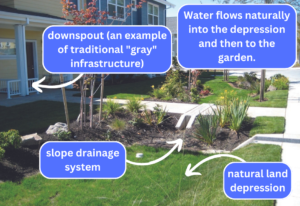As we learn more about climate change and humankind’s effect on the planet, a lot of people are looking to reduce our environmental footprint as much as possible. There’s endless advice about how to do that — you can check out some of our own tips about water conservation here — but have you thought about the role that infrastructure might play?
From utility and water lines to roads and sewer systems, infrastructure like this is necessary for the success and development of our society. But new ideas are emerging about how to make infrastructure eco-friendly as well as useful. Green infrastructure is the latest way to manage storm water runoff, and it aims to be as nondisruptive as possible to the natural water cycle.
Every community must deal with storm water, which refers to excess rain or snowfall. Whether you live in a city or a farm, storm water management is necessary to avoid flooding. There are a number of traditional drainage systems, but these systems will always have an environmental impact. But these systems will always have an environmental impact. Green infrastructure is conscious of water conservation and restoration on top of storm water management. The end result is natural as well as effective.
Most communities currently have “gray” infrastructure. Pipes and gutters make up most of these drainage systems. The water is guided to these pipes and then routed toward a large body of water, field or water treatment plant.
As much of this equipment ages, cities are opting to replace it with green infrastructure. The Environmental Protection Agency (EPA) gives several examples of what this could look like. A bucket in your yard, for example, would collect rainwater, which you could use for watering plants or other tasks. Conserving open natural spaces and wetlands allows water to collect and rejoin the natural water cycle. As American Rivers explains, green infrastructure is all about choosing the better option for the environment.
To see an example of green infrastructure in action, look no further than a rain garden, a landscaping technique that’s gaining popularity for both its look and its environmental benefit. These gardens are planted in a land depression, which encourages the water to flow down into the garden and soak into the soil. Not only does this keep your flowers watered (without your water bill taking a hit!), but rain gardens can also prevent pollutants from spreading into the environment.
This brings us to another big benefit of green infrastructure: It can cut back on our water pollution. When storm water runs off a roof or through a ditch, it picks up the pollutants on these surfaces. We certainly don’t want fertilizers, pesticides and dirt in our natural water sources. These chemicals and bacteria can sicken the animals and fish who rely on these water bodies. And while our drinking water goes through a treatment process before it’s delivered to us, we always run the risk of consuming these pollutants. At the very least, it makes the water treatment process more expensive.
As the EPA puts it, “soaking up the rain” is one of the most effective ways to prevent water pollution from spreading. Think again of the rain garden. Instead of traveling into the street, down a storm drain and then through a labyrinth of pipes to a water source, the storm water stays “on-site,” which greatly reduces its exposure to pollutants. This cleaner water can now soak into the ground, helping the vegetation and adding to our groundwater supply. The water goes right back into the water cycle without human interference.
Because the water is traveling over a shorter distance of land, green infrastructure also prevents erosion. Any farmer can tell you how important it is to keep our land intact; otherwise, we lose crops and might even run the risk of population displacement in extreme cases. Infrastructure like rain gardens collects water that might otherwise run down a hill through a traditional slope drainage system. Outside of the Midwest, living shorelines create a natural buffer against ocean waves by using native plants, reefs and sand. The EPA points out that this also creates a natural aquatic ecosystem. Every area has its own version of green infrastructure that’s suited to their environment.
That’s the main benefit of green infrastructure: Not only does it provide the water and storm water management we need, but it also promotes natural processes and environmental healing. If we can greenify our infrastructure, we can help the environment while also promoting the development that’s so integral to modern society.
At Heneghan and Associates, P.C., we’re well-versed in water, wastewater and storm water engineering, and we’re always looking for new ways to help our community. As engineering evolves, we’ll be evolving with it. To learn more about green infrastructure or other engineering options, contact us or visit our website!


